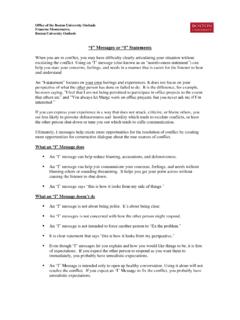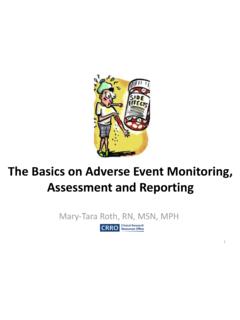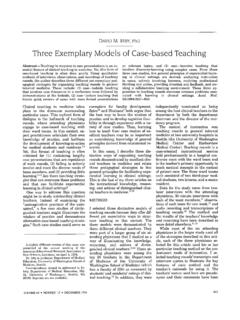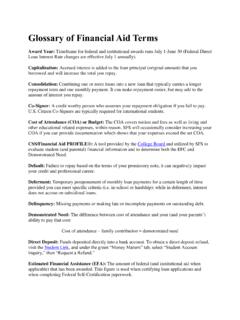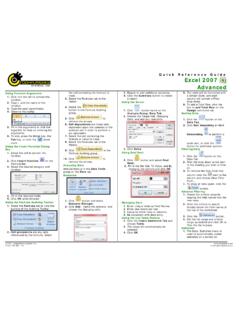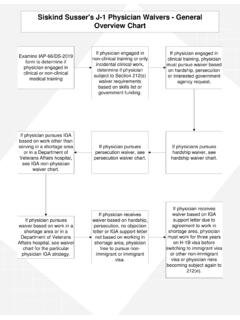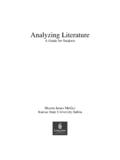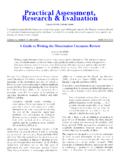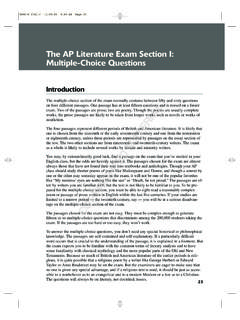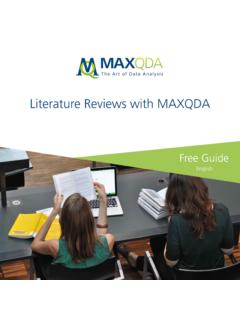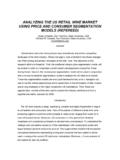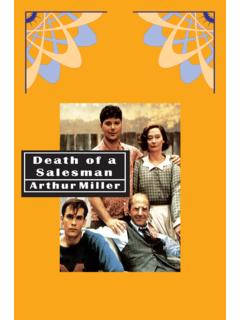Transcription of Analyzing Qualitative Data: With or without software
1 4/19/10 1 Analyzing Qualitative data : with or without software Sharlene Hesse-Biber, Department of Sociology Boston College Chestnut Hill, MA 02467 Role of the Researcher YOU are a data collection instrument You take notes and decide what topics to record How much do you set the agenda What questions do you ask or not ask? What do you deem important? Role of the Researcher You are driving the analysis: What are your implicit/explicit theories? What is your favored analysis method(s)? Role of the Researcher You make decisions before analysis based on your: Epistemological perspective Approach to the problem Particular research questions How should I analyze my Qualitative data ? Depends on: What research questions drive your study. Research Question is linked to methods chosen and type of analysis rationale you apply.
2 Role of Transcription in analysis of your data Builds theoretical sensitivity (Strauss & Corbin, 1990) Brings the researcher closer to the data Provides a unique opportunity to critique and improve on the interview process Copyrighted Hesse-Biber Qualitative Analysis Consulting What is Transcribed? Written texts: Field notes Supporting documents Audio and/or Visual data Recordings of interviews, focus groups, consultation Photos Videos Copyrighted Hesse-Biber Qualitative Analysis Consulting Researcher Positionality The researcher s viewpoint is part of transcription How does your set of social, economic, personal, and other characteristics impact the way you represent your data ? Copyrighted Hesse-Biber Qualitative Analysis Consulting Issues of Representation Whose transcription are you creating? Address issues of authority and representation.
3 Transcription and data analysis reflection: Recognize ways that data are interpreted and represented. How do you decide what to transcribe (everything or only particular aspects)? Copyrighted Hesse-Biber Qualitative Analysis Consulting data Analysis: The goal is to analytically reduce your data by: Producing summaries, abstracts, coding, and memos Finding ways to your display data ( matrices, frequency counts, etc.) Draw conclusions and test their validity Remember: Analysis is an iterative and ongoing process Memo-ing: A critical link between your interview data and creation of codes and categories Memo about: Codes, categories, and their relationships Initial thoughts on data analysis Memos are ways of Summarizing where you are at during your analysis and potential interpretations you may have about your data . Analysis is saying: What does the data say.
4 Interpretation is saying: What does it mean? data Analysis as data Reduction Management goal is to make large amount of data manageable Analysis goals: Search for commonalities, which lead to categories (know as codes or themes) Search for contrasts/comparisons There is Physical reduction of data (putting names on excerpts as if you are creating labels in a filing cabinet with no analytical bite Conceptual reduction of data : Thinking through meaning by coding memo-ing re-coding for meaning data how do I do this???? Know your data : listen, read, and think about it Know your biases and standpoint Focus on the data one way is to take a grounded approach. But remember there are multiple analytical styles ( narrative analysis, content analysis, etc. Go back to your research question to determine analytical rationale Coding Styles: Deductive Coding of your data Starts with pre-set themes/codes/categories Themes suggested by research literature, advisor, etc.))
5 Provides direction in your analysis Yet: Do you want to start out with a set of themes a priori? Why? Go back to your research question. If you are exploring new territory it may not be best to start out looking for a something. Inductive coding style: Iterative analysis (often referred to as a Grounded Analysis. Your analysis codes come directly from reading/thinking about data Part of iterative process that is often a like an upward spiral in which you go up and down the twists and turns almost like a dance-- a tango that has no straight lines. Inductive (Grounded) Analysis Iterative process After initial coding, go back to change and break down codes Developing Grounded Codes Code: symbol applied to a section of text in order to easily categorize it Related to research questions, themes, concepts Used for retrieval and organization Finish coding when saturation is reached Developing Grounded Themes During and after coding, look for connections between codes Begin with descriptive themes Look for subcategories, relationships, cause-effect Develop a matrix of codes and themes Differentiating Types of Grounded Codes: Tag Code Category Themes Using software to Analyze Qualitative data Transcription software : Using HyperTranscribe Computer-Assisted software : Using HyperRESEARCH Advantages of Computer-Assisted Qualitative data Analysis (CAQDAS).)
6 Enhances ability to play with the data Assists in development of organizing system Theory building and construction Exploring different possibilities of data analysis and interpretation Copyrighted Hesse-Biber Qualitative Analysis Consulting Advantages of CAQDAS Create and share large data sets Access facilitates group projects Allows for secondary analysis of Qualitative data sets Copyrighted Hesse-Biber Qualitative Analysis Consulting Advantages of CAQDAS Facilitates exploration of epistemological issues Works as a pedagogical tool for Qualitative research methods Copyrighted Hesse-Biber Qualitative Analysis Consulting Transcription as Analysis with Computer software Transition marker: using time stamps to highlight transitions, etc. Mark text in color Insert memos using representative fonts Copyrighted Hesse-Biber Qualitative Analysis Consulting Benefits of Transcription Technologies Decrease time and money spent on transcription More easily used by junior team members Simplified technologies allow researchers to do own transcription Copyrighted Hesse-Biber Qualitative Analysis Consulting HyperTRANSCIBETM Allows you to watch or listen to video or audio file during transcription and take memos on the fly Single interface for media and transcription Allows you to time-stamp your transcription for easy retrieval and analysis on the fly Hands never have to leave the keyboard Supports common video formats such as AVI, QuickTime, MPEG-2.
7 MPEG-4 Copyrighted Hesse-Biber Qualitative Analysis Consulting HyperTRANSCIBETM HyperTRANSCIBETM Simple control over timing options Copyrighted Hesse-Biber Qualitative Analysis Consulting HyperTRANSCIBETM Add text shortcuts to speed up the transcription process Copyrighted Hesse-Biber Qualitative Analysis Consulting HyperTRANSCIBETM Download a free demo at Copyrighted Hesse-Biber Qualitative Analysis Consulting HyperRESEARCH CAQDAS for Win and Macintosh Used for a variety of fields and analytical styles Facilitates group work Allows code and retrieval of data : Boolean/proximity searches Auto-coding and viewing codes in context Copyrighted Hesse-Biber Qualitative Analysis Consulting HyperRESEARCH Uses AI to create complex code categories Summary memos on data documents Hyperlinking Theory building Hypothesis testing Cognitive mapping Code lists Copyrighted Hesse-Biber Qualitative Analysis Consulting HyperRESEARCH Links Qualitative and quantitative Export matrices Import quantitative data Detailed summary reports Copyrighted Hesse-Biber Qualitative Analysis Consulting Study Structure Copyrighted Hesse-Biber Qualitative Analysis Consulting Text Source nText Source 02 Text Source 01 Image Source nImage Source 02 Image Source 01 Audio/Video Source nAudio/Video Source 02 Audio/Video Source 01 Case 01 Case 02 Case nStudyCase Card Copyrighted Hesse-Biber Qualitative Analysis
8 Consulting View codes in context Copyrighted Hesse-Biber Qualitative Analysis Consulting Code List Editor Copyrighted Hesse-Biber Qualitative Analysis Consulting Memoing in Master Code List Define code categories on the fly Copyrighted Hesse-Biber Qualitative Analysis Consulting Selecting Cases or Codes Select all Select by choosing from a list Select using a Boolean expression (note: All subsequent browsing or analysis is done using the SELECTED subset of cases and codes) Copyrighted Hesse-Biber Qualitative Analysis Consulting Selecting Cases or Codes Overlaps Includes Equals Copyrighted Hesse-Biber Qualitative Analysis Consulting Coding Copyrighted Hesse-Biber Qualitative Analysis Consulting HyperRESEARCH adds codes on the fly. Or use the Master Code List Editor to add codes without attaching them to text or media segments A code definition may be added for each master code.
9 30,000 characters/code Code Map Copyrighted Hesse-Biber Qualitative Analysis Consulting Coding Images Copyrighted Hesse-Biber Qualitative Analysis Consulting Image FROM: Coding Video and Audio Copyrighted Hesse-Biber Qualitative Analysis Consulting Image FROM: Running Reports Copyrighted Hesse-Biber Qualitative Analysis Consulting Copyrighted Hesse-Biber Qualitative Analysis Consulting Auto Code: Choose Sources Copyrighted Hesse-Biber Qualitative Analysis Consulting Auto Code: Choose Phrases Reporting Based on cases and codes Display, print, or export A report is based on the set of cases AND codes you have selected. The checkboxes specify which elements are included a report. Reports may be displayed, printed or exported Copyrighted Hesse-Biber Qualitative Analysis Consulting Hypothesis Tester & Theory Generator Copyrighted Hesse-Biber Qualitative Analysis Consulting Integrating Qualitative Analysis with software : A Step by Step Approach with some examples of the how to s Copyrighted Hesse-Biber Qualitative Analysis Consulting Exploration Phase Copyrighted Hesse-Biber Qualitative Analysis Consulting Computer Function Assign codes Attaches codes to text segments.
10 Automatic coding or words and phrases Steps in Analysis Read text and think of codes (also referred to as indexing or tagging Assign codes to segments Add Codes to Text Copyrighted Hesse-Biber Qualitative Analysis Consulting Exploration Phase Steps in Analysis Clarify codes if necessary Writing memos about codes and new directions in research; link codes to the research questions Computer Function Assigns codes, overview of codes, create theory memos, attach memos to text/codes Memoing,theory memos, formulate new questions / hypotheses Copyrighted Hesse-Biber Qualitative Analysis Consulting Line by Line Coding Text: Code: I always wanted to be the thinnest, the prettiest Thinnest, Prettiest I wanted to look like the girls in the magazines I m going to have so boyfriends and boys are going Pos. body image Going to be so in love with me, I won t have to Provides economic resources work and I ll be taken care of me for the Thin Rationale rest of my life Thinness as security Media Standards Copyrighted Hesse-Biber Qualitative Analysis Consulting Evaluation of codes Initial codes in Eating Disorders Study were changed as follows: FROM: TO: Clothing made for thin clothing that fits Weight lower concerned with weight appearance Minimal over body and eating creates standards Dating and control women by appearance Will always want to be thinness Thin rationales.)
